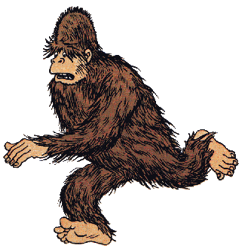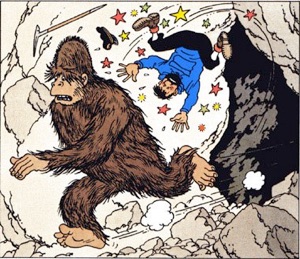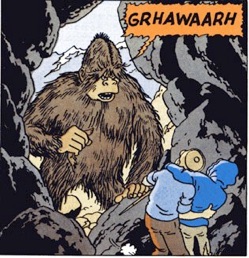The Yeti DNA sequenced (reactions)


The Yeti DNA sequenced (reactions)




Back to the
page “PICS, MEDIA & CO”
Back to the
“LANE”
introduction page

FACTS
Species:
‣Yethi vulgaris
Location:
‣Tibet, Nepal

PUBLICATIONS
‣Molecular Phylogenetics & Evolution 31: 1–3 (2004)
(1st of April issue)

MAIN COLLABORATORS
Gisella Caccone
Group leader at Yale University.
Georges Amato
He was in Jeff Powell’s lab during the “Yeti story” and he is now Director of the Center for Conservation Genetics and Sackler Institute for Comparative Genomics at the American Museum of Natural History, New York, USA

Other collaborators and sample sources
‣Peter Matthiessen
Is a two-time National Book Award-winning American novelist and nonfiction writer as well as an environmental activist. He frequently focuses on American Indian issues and history, as in his detailed study of the Leonard Peltier case, In the Spirit of Crazy Horse. In November 2008, at age 81, he received his second National Book Award for “Shadow Country”, an 890-page revision of a trilogy of novels he released in the 1990s. His first National Book Award was won in 1980 for “The Snow Leopard”. His story “Travelin' Man” was adapted into the film “The Young One” by Luis Buñuel.


Some reactions to 1st-of-April article:
Molecular phylogenetic analyses indicate extensive morphological convergence between the ‘‘yeti’’ and primates
By Milinkovitch M. C., Caccone A. & G. Amato.
Molecular Phylogenetics and Evolution 31: 1–3 (2004)
John C. Avise (University of Georgia, Athens, USA) wrote:
Dear Michel,
I love your article on the phylogenetic position of the yeti in MPE. I do have a serious question about the paper though: Did you actually get sent hairs that someone seriously claimed to be yeti, and did you then genuinely assay those hairs and find them to be of ungulate origin? Or, is the entire story a spoof from start to finish? I think the answer is that you genuinely conducted this study, but I want to know for sure. The reason is that I am currently writing a book about phylogenetic character mapping, and I would like to include your example (for the fun of it), but I want to be sure about just exactly what you did. Thanks. Best wishes, John.
My answer:

➡John then reported on the Yeti story in his book “Evolutionary Pathways in Nature: A Phylogenetic Approach”, Cambridge University Press (2006)
Some other reactions
✓Dear Michel. Thanks very much for this. When you finally find positive genetic evidence for the yeti, please consider Nature! We have a strong record in cryptozoology: see for example Anon., ‘Naming the Loch Ness monster’, Nature 258, 466-468 (1975). All best. H. Henry Gee (Editor at Nature, London, UK)
✓Dear Dr Milinkovitch. It is with a very great pleasure that I have read your enlightening study in MPEV (Molecular phylogenetic analyses indicate extensivemorphological convergence between the ‘‘yeti’’ and primates) although slightly disturbed by the results you obtained. I am presently finishing my PhD on phylogenetic relationship of yetis, sasquatches and the likes using stool DNA. I have also developed microsatellites for this group. My results (soon to be published) clustered the yeti with a residual group of primates: The Flammishs. Therefore, I am exhilaratingly happy to have the pleasure to submit to you my application for a post-doc in your lab. We could also collaborate on my review: "How to get famous in Science when you didn't make it with magic bacterias or by hiring the prettiest blond PhD student in the world". Congratulations ! Hope to hear from you again ! Séb. Sébastien Regnaut (Dpt Ecologie et Evolution, Université de Lausane)
✓Hallo guys! I read your hilarious paper !! A lot of fun ! I told my wife your conclusions and she told me that if you really want to understand what convergence means you should study some of my hair.............I didn't get it........... ciao. Gabriele. Gabriele Gentile (University Tor Vergata, Rome, Italy)
✓I loved your Yetti paper! A true masterpiece! Why can't more people have a sense of humor in science? Allan Lemmon (Univ. Texas, USA)
✓Michel, I read with great interest your recent and fascinating report on the Yeti! Clearly a cautionary tale for all evolutionary biologists who are quick to assert relationships based upon dubious and convergent characteristics. It actually is very timely, as I wanted to ask you about a collaborative venture. As you are well aware, there is a very strange mammal in the high plains of Wyoming that is small with long ears and legs, a short tail, and hops around. It also has antlers. It is called a jackalope. There has been much debate as to whether it is more closely allied with the jack-rabbits or the antelope. You interested in putting this controversy to rest? :-) Dean.
P.S. Seriously, I did enjoy the paper, and it is good to see that not all scientists have lost their sense of humor! I hope all is well for you. Dean C. Adams (Iowa State University, USA)
✓I had seen your MPE paper about a week before the 1st of April. Kim and I thought you were loosing it :-) Cool paper! Franky
PS: That new frog family was a joke too of course ... but they didn't realize at Nature. Franky Bossuyt (Brussels University, Belgium)
✓Dear Sir, I am a molecular geneticist working with human mtDNA markers to answer questions on human evolution. I have read your paper "Molecular phylogenetic analyses indicate extensive morphological convergence between the ‘‘yeti’’ and primates", and would like to compare the sequence of the "Yeti" with other human mtDNA sequences. As you have not indicated the Genbank (or other database) accession number, kindly provide me with the sequence of the Yeti hair sample. I would be very grateful for the same. Yours truly, [Name undisclosed].
Some reactions in French
✓C'est évidemment un coup de plus de l'establishment scientifique anglo-saxon. Cela dit, manque quand même une référence "neutre" test..un vertébré, comme un poisson par exemple. Beau travail en tout cas...s'il est reproductible; Cordiales - et envieuses - félicitations. Paul. Paul Galand (IRIBHM, Belgium)
✓Michel c'est vraiment excellent . Ce qui étonne c'est que l'on ne donne aucune information concernant la filliation du Yéti avec le poisson...Geo. Georges Huez (IBMM, Belgium)
✓Excellent! J'ai savouré chacune des lignes du papiers, en particulier les refs aux auteurs!! Magnifique! Val. Valérie Ledent (IBMM, Belgium)
✓Excellent ! C’est bien la première fois que je me marre en lisant un article dans MPE !!! Arnaud Termonia (Belgium)
✓Cher Pr Milinkovitch, Je suis doctorant à l'ULB dans le service d'Océanographie chimique et Géochimie des eaux au campus de la Plaine à Bruxelles mais néanmoins très ouvert aux préoccupations cryptozoologiques. Je suis à la recherche d'un article dont vous êtes l'auteur et que j'aimerais classer dans la liste de mes références bibliographiques pour faire partager l'humour belge avec mes collègues étrangers. En voici la référence: Molecular phylogenetic analyses indicate extensive morphological convergence between the "yeti" and primates. Pourriez-vous m'en faire parvenir une version électronique s'il vous plait? Sincèrement, Jérome Harlay (Belgium)



